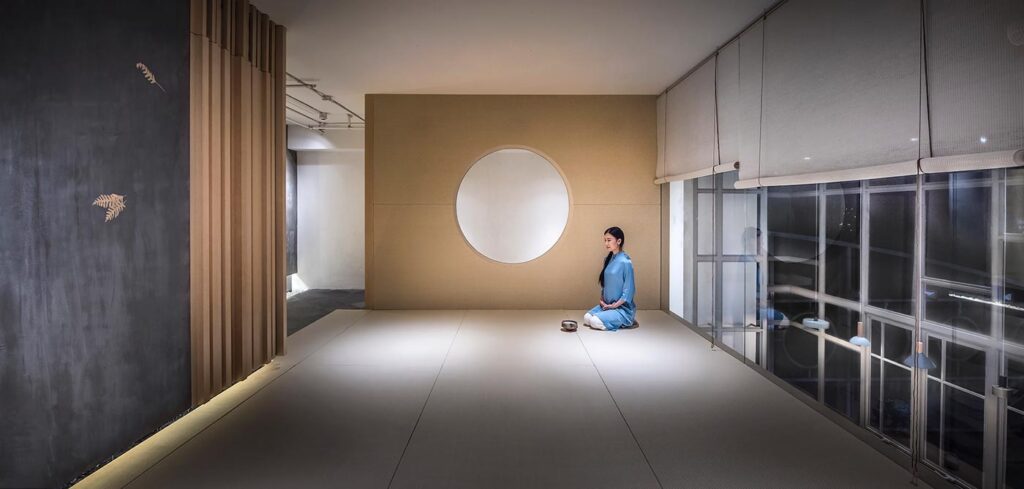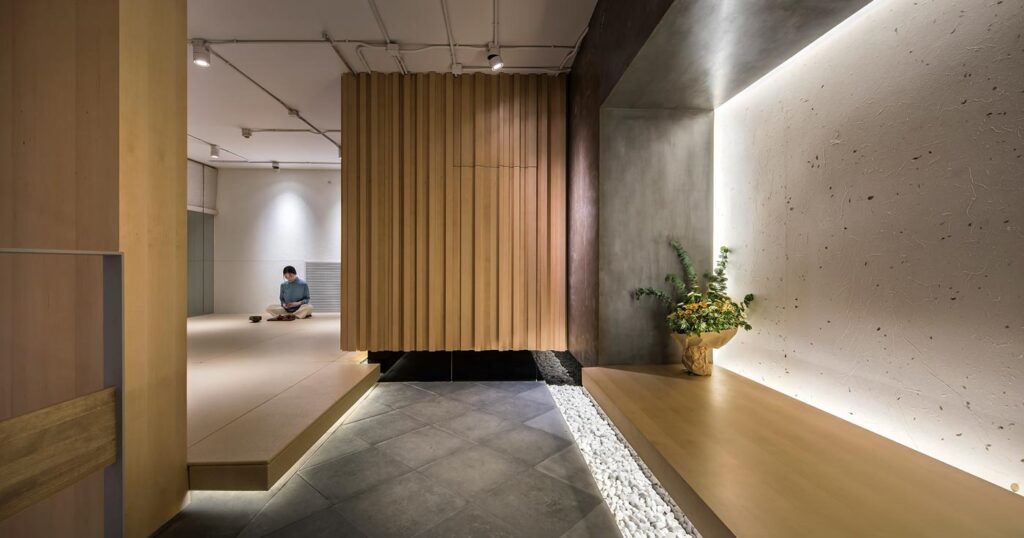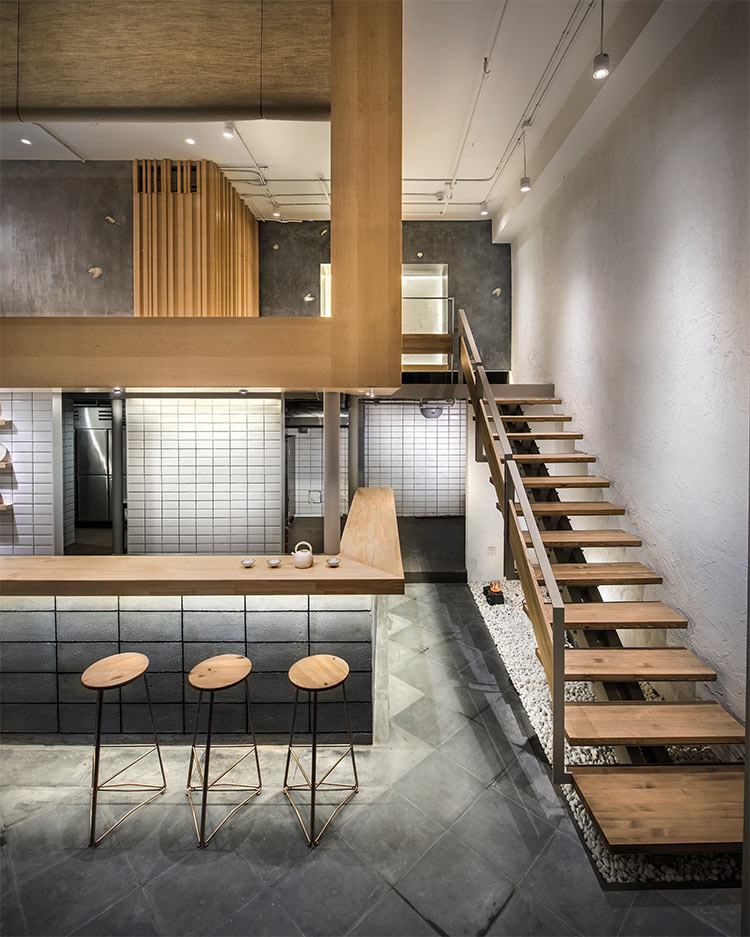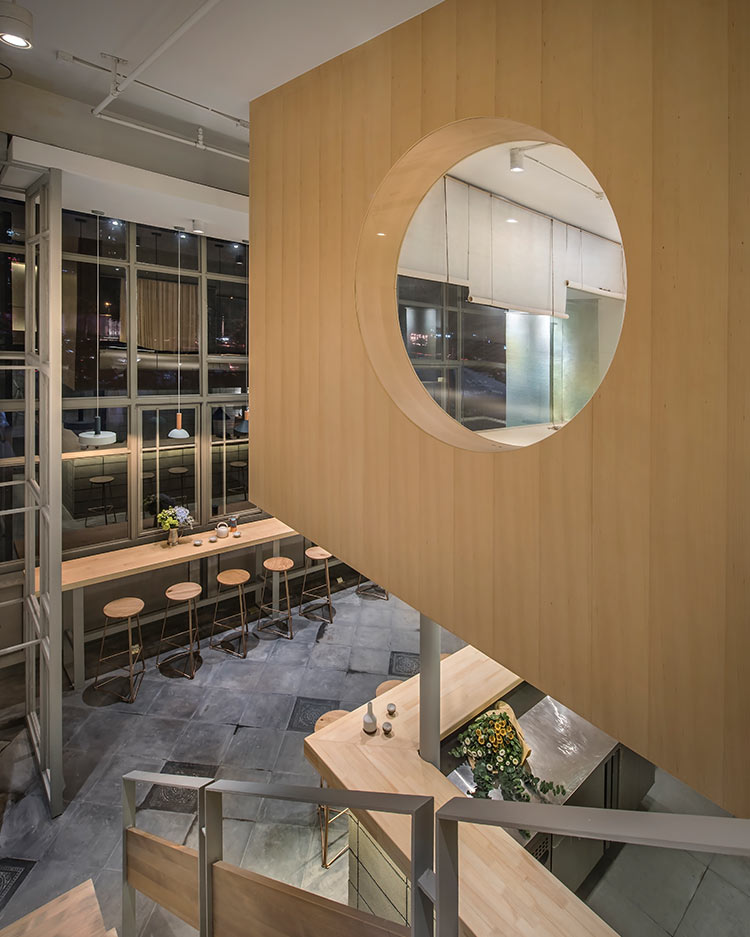Hidden behind the busy scene of CBD Beijing, at the street corner of a local residential area is this small noodle soup restaurant called Qing Huan. Through its two-story-high glass and steel facade, the beauty of its simplicity reveals. The proportion of the divisions on its facade mimicthose from traditional Chinese architecture, though it also looks as if it follows the golden ratio praised by the West. With its small scale, this humble noodle shop unveil a timeless architectural beauty.
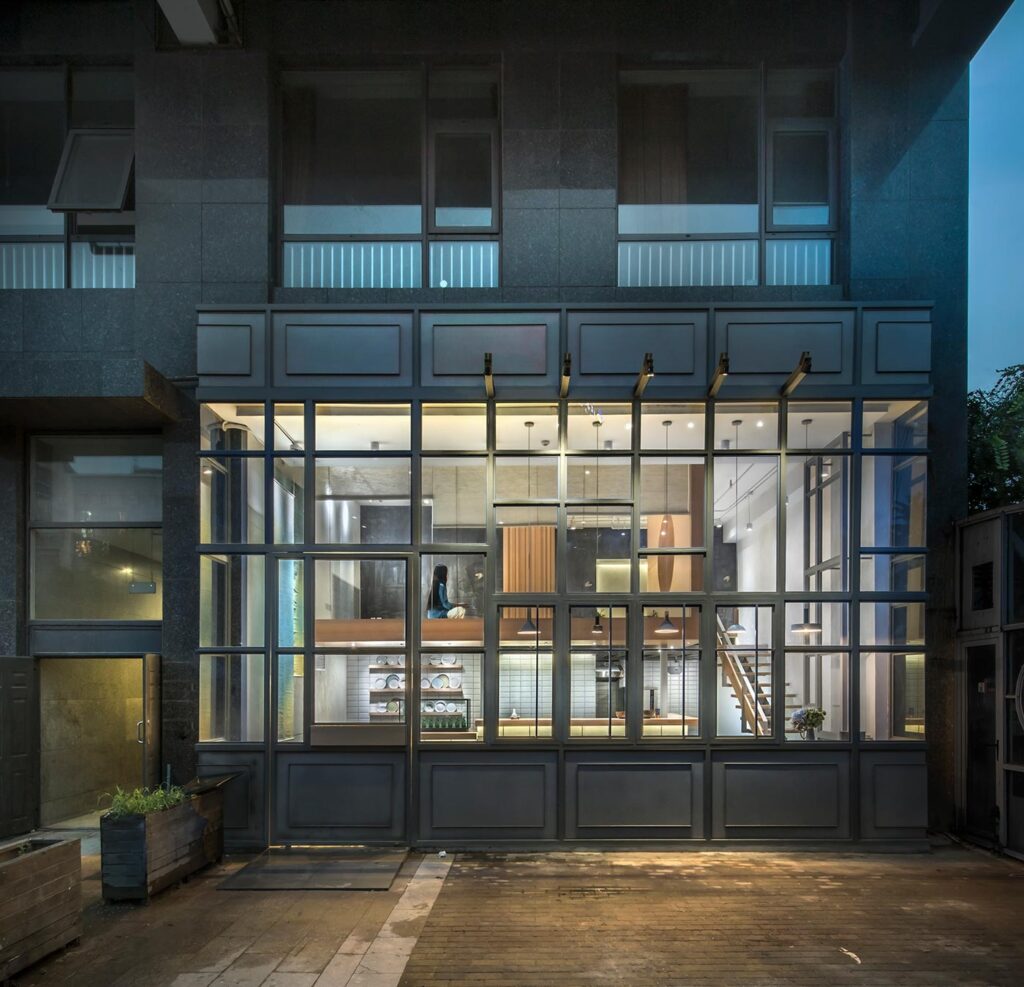
The transparency of the facade maximise the visibility of the restaurant, lighting up the neighbourhood at night with a warm ambient.The glass and iron facade has a classical, almost nostalgic look, with the top and bottom transom panels made with concrete fibre board and overhanging windows in the middle. Inside the restaurant behind the huge glass entrance door, the grey terracotta floor tiles set against the lightweight concrete tiles under the bar counter. Together with the solid pinewood countertop and matte white tiles behind the open kitchen, it effortlessly creates a contemporary minimalistic interpretation of modern Chinese cuisine. For many Beijingers of the younger generations, a quick bowl of warm beef or chicken noodle soup may be all that it takes to comfort the stressful city lives in the capital.
Tucked in the corner next to the bar counter is the steel staircase that lead the special guests up to the dining room on the upper floor. Away from the busy open kitchen, it offers a precious tranquil dining experience. The recessed glass front of the upper floor yields a dramatic height for the ground floor, and provides the desired openness and privacy for the upper floor.
Walking up the staircase, one can caught a glimpse of the second floor as if it is a floating timber box above the ground floor. The moon window on the side reveals the zen ambience of the dining room, at the same time a picture frame from the inside capturing everyone passing by.
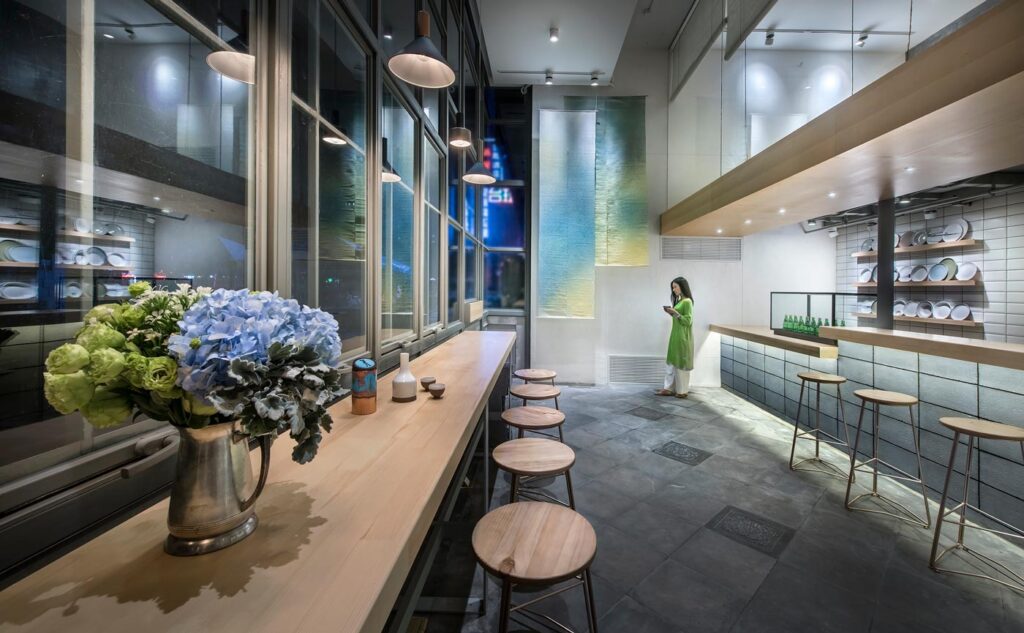
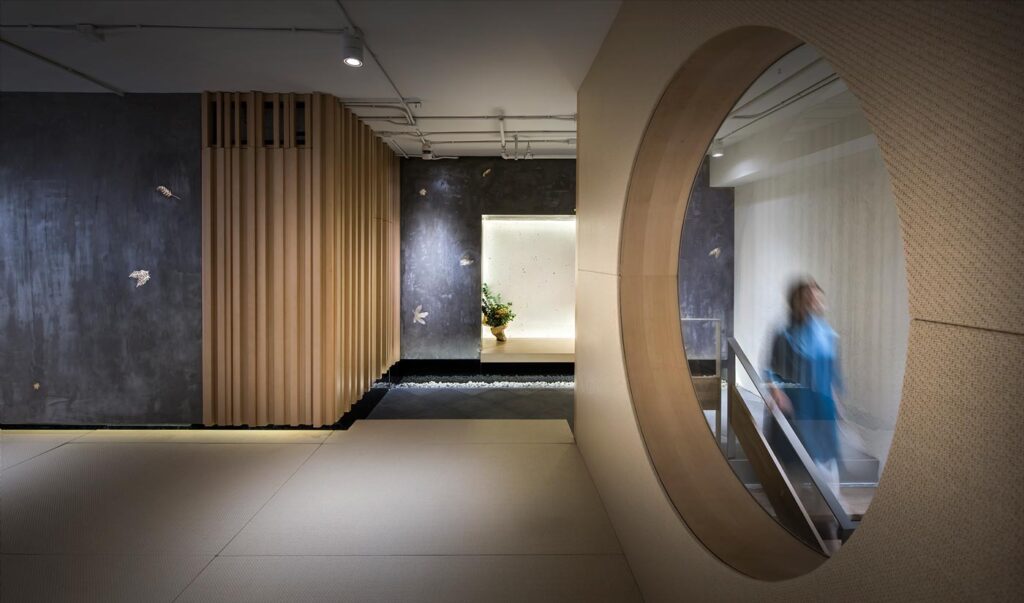
Unlike the vast openness of the ground floor, the upper floor is an intimate minimalistic secret zen garden. Inspired by the design of an ancient tea house, the cozy space is surrounded by abstract elements of nature. The falling leaves are frozen in time captured by the copper inlays on the concrete wall. The vertical timber strips mimic the intertwining tree trucks in a forest. Behind the timber bench in the middle, a special handcrafted calligraphy paper with green tea leaves is used as wallcovering. The translucent paper creates an illusion that the green leaves is dancing in a spring breeze beyond.
All of these detail are made possible to hide the guest washroom and store room behind the timber strips and the exhaust conduits from the kitchen below. Both functionality and aesthetic are combined and translated into poetry.
Simplicity is the key factor for the success of the design of this little noodle shop, to maximize its versatility and comfort within such a small space, yet creating a unique character that speaks of contemporary Chinese cuisine. All materials are used at their most original state to emphasize the beauty from within. Inside the upper dining room for example, the wall and floor is covered by woven rattan mat. The mat provides asoft warm tactile finish to the space, and at the same time a relaxing atmosphere that can only be achieved with the material itself.
Under the evening sky in the neighborhood, the street is lit up by the inadvertently placed copper pendent lamps above the barcounter. Inside the kitchen, the shopkeeper watches city dwellers coming and going, passing by the shop throughout all seasons. Time passes in a blink, and life is as simple and beautiful as a bowl of noodle soup.
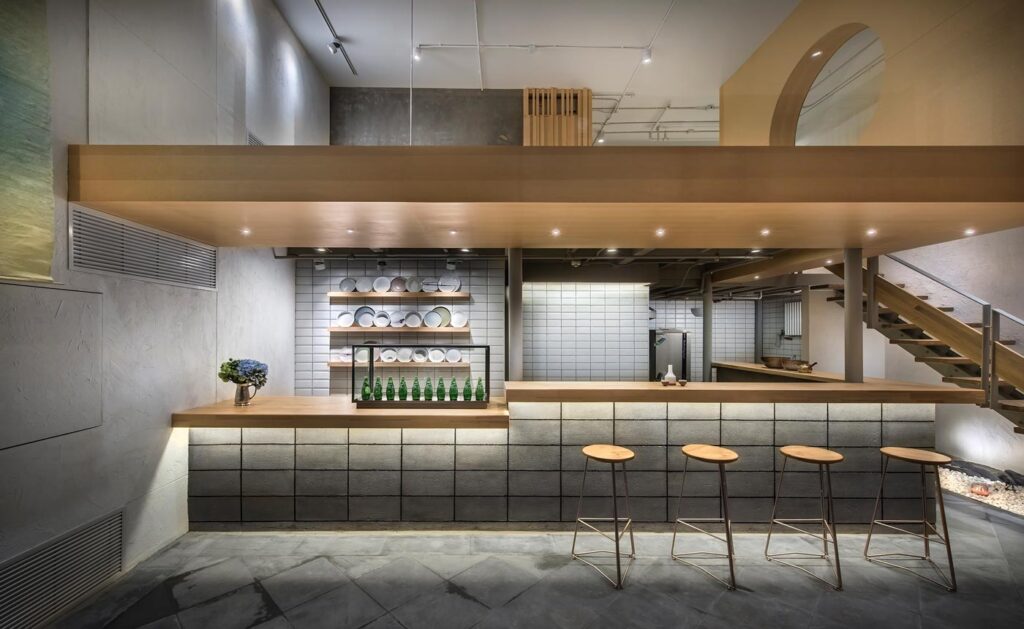
一爿小店,一间门面,就这样安静地坐落于京城民居小路边上,隐藏于路旁转角茂密花草树木后面的,是简洁硬朗的线条构造而成的钢框玻璃门脸,外表如材料一样简约现代,且富工业时代感,细看却能感受到隐隐含蓄古典意味,门窗的结构比例带有中式建筑特色,却同时富含西方黄金分割演变而出的美感。一仗麵擀,一袭红袍,一段缅怀,开启了一段有趣的碰撞。秉著传承与创新,将传统用轻巧手法表达又不失层次感和深度;一个小空间,包含了时空穿越概念,中西融合风格,与亦古亦今韵律,更是有趣。
通透且立体的外立面,让整个店的宽度和深度达到最大化,仿佛把室内氛围延申至室外前院;店内设计素雅简洁,透出一丝古典,场景尤如从古代酒楼膳房穿越而来的大厨掌勺,对现代用餐设计重新解读。进门一楼青灰花砖铺地,前后两道原木色长条吧桌迎来各路客官,揣上一碗碗热腾腾的汤面,大厨从老家带来的食材和香料把整个小店薫满了家的气息。白素泥墙前错落挂著淡彩条幅,像是在透露著简单一碗热汤面里的各种精彩,清水混凝土砖在灯光的配合下散发出纯真的温暖,和开放厨房里的白色瓷砖形成有趣的视觉和质感的对比,让小空间变得更干净简练。吧台上方是二楼的小包间,包间外的后退玻璃墙既能使一楼二楼同时拥有最大限度的室外景观,亦为一楼提供了一个超高的挑空空间。从通透的钢木结构楼梯往上走,仿如穿越时空,自成一格的二楼如亭台楼阁,凌空驾驭在现代繁华都市里,阶梯底下白色鹅卵石和大理石板造景,以成岭成峰的远山意境,道法自然。
上走到二楼侧身经过庭院感十足的月洞门,侧瞰一下包房里的极简意境,人亦被框进二楼的景。到达二楼后,面前是落叶化成古铜被凝固在深灰色素水泥墙上,与抽象描绘树林错落有致的木条造型,是写意亦是写境。中心的木质长塌,配以茶叶宣纸装饰的内嵌墙面,禅意十足。宁静与雅致的二楼小包间以藤席铺地,隔著全透玻璃既可看到楼下空间,与楼下形成看与被看的空间格局,又可放下卷帘,独成一格。
这一切墙体结构与层次重迭交错,既表达设计意境,亦将厨房的排烟系统隐藏在内,而木条造型后中的隐藏门后更是洗手间,是功能与美观的完美结合。设计中运用了见树不见林的手法,让空间充满婉转、抽象、好奇,并融入古代庭院花园的概念,让观景者本身亦为景,让客人见著了风景,亦使自己成为景的一部分。
选材上呼应了定位与空间意境,运用简单原始的材料透过不同手法碰撞出新火花:角铁、玻璃、水泥板排布切割出既古典又现代的通透外立面;水泥刮出了历史的刻痕,想起了记忆中的那道斑驳的灰牆;板岩与鹅卵石勾勒出苏州庭院的想像;茶叶宣纸作为壁纸,书画茶香引人入胜。
从通透的门脸外看进小店,随著人的活动,不同时间不同季节,有著不一样的表情,活泼生动;夜幕下搭配窗边古铜吊灯,暖光轻启,在闹市中,透过简洁的线条让人眼前一亮,点上一碗米粉,人间有味是“清欢”。
